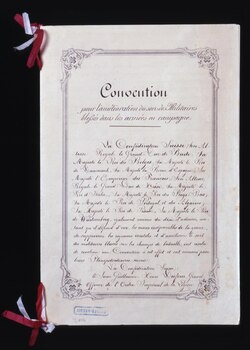
Back Geneefse konvensies Afrikaans اتفاقيات جنيف Arabic اتفاقيات جنيف ARZ Convenciones de Xinebra AST Cenevrə konvensiyaları Azerbaijani Жэнеўскія канвенцыі Byelorussian Жэнэўскія канвэнцыі BE-X-OLD Женевски конвенции Bulgarian জেনেভা কনভেনশন Bengali/Bangla Kenemglevioù Geneva Breton


The Geneva Conventions are international humanitarian laws consisting of four treaties and three additional protocols that establish international legal standards for humanitarian treatment in war. The singular term Geneva Convention colloquially denotes the agreements of 1949, negotiated in the aftermath of the Second World War (1939–1945), which updated the terms of the two 1929 treaties and added two new conventions. The Geneva Conventions extensively define the basic rights of wartime prisoners, civilians and military personnel; establish protections for the wounded and sick; and provide protections for the civilians in and around a war-zone.[2]
The Geneva Conventions define the rights and protections afforded to those non-combatants who fulfill the criteria of being protected persons.[3] The treaties of 1949 were ratified, in their entirety or with reservations, by 196 countries.[4] The Geneva Conventions concern only protected non-combatants in war. The use of wartime conventional weapons is addressed by the Hague Conventions of 1899 and 1907 and the 1980 Convention on Certain Conventional Weapons, while the biological and chemical warfare in international armed conflicts is addressed by the 1925 Geneva Protocol.
- ^ "The 1864 Geneva Convention - ICRC". www.icrc.org. 18 August 2013. Archived from the original on 25 August 2023. Retrieved 25 August 2023.
- ^ "State Parties / Signatories: Geneva Conventions of 12 August 1949". International Humanitarian Law. International Committee of the Red Cross. Archived from the original on 17 January 2013. Retrieved 22 January 2007.
- ^ "The Practical Guide to Humanitarian Law: Protected Persons". Doctors Without Borders. Archived from the original on 21 September 2023. Retrieved 24 August 2023.
- ^ Cite error: The named reference
untcwas invoked but never defined (see the help page).